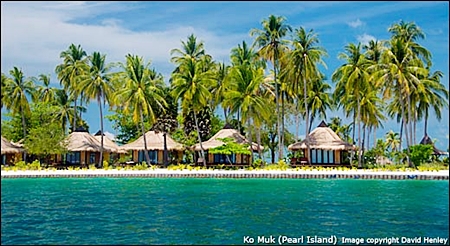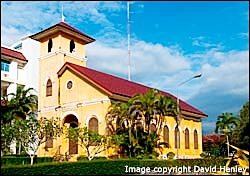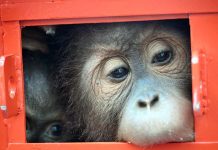The southern Thai province of Trang, tucked away on the Andaman Coast between Krabi and Satun on the Malaysian frontier, is rich in history, providing a fascinating showcase for the south’s flourishing Sino-Thai cultural traditions, architecture and food – and the proud locals love to prepare and share it with visitors. Its lovely and unspoiled coastline consists of more than forty offshore islands. Trang is a place to experience the delights of the deep south in an authentic and relaxing atmosphere.
Culture and Way of Life
Trang – formerly called Thap Thiang – is a quietly prosperous town with a long history as a trading port dating back more than a thousand years to the time of the Srivijayan empire.
While rural Trang is decidedly southern Thai in character, Trang city retains a distinct Sino-Thai feel. This is manifested in the population, in the architecture of the shop houses, Chinese shrines, and Trang’s distinctive cuisine.

In its present incarnation, the town only developed as an important commercial centre in the 19th century due primarily to the settlement of Han Chinese migrants from southern China. For more than a century its people have prospered from extensive rubber plantations, rich fisheries and fertile agricultural land, attaining one of the highest provincial per capita incomes in Thailand.
Chuan Leekpai, who became leader of the Democrat Party and prime minister of Thailand between 1992-95 and 1997-2001, is a native of Trang. Chuan put Trang on the tourism map. A third generation Sino-Thai, Chuan was born in Trang in 1938, the son of a local teacher of modest means. Now retired and a popular father figure for the Democrat Party, he remains one of Trang’s favourite sons.

A Tour of Historic Routes by Tuk Tuk
The town of Trang is relatively spread out. This makes a walking tour of the various attractions quite time consuming. Fortunately the tuk tuk hua gop, a local style of motorized three-wheeler that has been around for at least 60 years, and which – viewed from the front – looks rather like a frog, is readily available.
Sacred Sites
Trang is a model of cosmopolitan coexistence. Thai Buddhist temples, Chinese shrines and a distinguished old Christian church exist side by side, reflecting the city’s culturally diverse past.
There are several Chinese shrines scattered across the city including Kuiyong La and Paokong. Both are a riot of red and gold lanterns, characters and san jiao images from the Chinese triple religion of Buddhism, Daoism and Confucianism. Thamkong Tia joss house in the north of the city is particularly worth a visit for its rich Sino-Thai symbolism, including a leaping carp surmounting the elaborate entrance.
In the centre of town, amid some fine examples of restored Sino-Portuguese shophouses along Ratchadamnoen Road, are shops selling red paper lanterns, brass incense burners, figurines of Mahayana Buddhist and Daoist deities including kitchen god altars. All Trang’s joss houses are usually wreathed in smoke from burning incense coils and joss sticks, adding palpably to the mystical atmosphere.

To the north of the city centre, on busy Huai Yod Road, the Thap Thiang Church of Christ is the spiritual heart of Trang’s Christian community. The architecture of the attractive, ochre-coloured building evinces the spirit of the former Straits settlements of Penang and Melaka (Malacca), and provides another cultural pointer for Trang’s former cultural and commercial links.
Thai Theravada Buddhist temple architecture is represented by Wat Nikrodharam and Wat Kaphang Surin. Both are close to the still waters of Kaphang Surin, a lake popular for picnics to the north of town. More heterogenous, and a fine symbol of Trang’s cultural ‘unity in diversity’, Wat Matchimaphum – known locally as Wat Na Khao – brings a Mahayana element to the Theravada tradition by housing a large laughing Buddha, the much-venerated Phra Sangkajjayana image, and a golden Guanyin Goddess of Mercy statue on a tall plinth that overlooks the entire town.

Kantang Port
Just 22 kilometres southwest of Trang at the mouth of the Trang river, the old port town of Kantang, founded by Governor Khaw Sim Bee at the end of the 19th century, still houses Trang’s lak mueang (city pillar), the traditional spiritual heart of the city, locals believe it enshrines Trang’s prosperity and well-being. It is honoured by the locals with offerings of incense and puang malee jasmine garlands.
Heritage Homes & Museums
Kantang is distinguished by a number of old Sino-Portuguese buildings. These reflect the port’s former importance in the Andaman Sea trade between Phuket, Penang and Melaka. The most interesting of these, at 1 Khai Phitak Road, is the Phraya Ratsadanupradit Mahitsaraphakdi Museum, a two- storey wooden building that houses a waxwork figure of a celebrated early 20th century governor of Trang, together with a period collection of his furniture, pictures and personal possessions.

TRANG CULINARY TRADITIONS
Trang is well known for its various epicurean delights which, like the city itself, have developed from a happy fusion of Fujianese-Hokkien cuisine with southern Thai traditions including the use of coconut milk, searingly hot phrik ki noo chillis, peanut sauce and the odiferous but tasty sataw bean.
Perhaps the best time to sample Trang food is at breakfast. Nowhere else in Thailand offers the unusual combination of tender roast pork served with a choice of up to 25 different types of dim sum, known locally as tae tiam.
Trang roast pork, or moo yang Trang, is cooked according to a special local recipe which involves marinating the pork in a mixture of local herbs before spit-roasting it to a point where the skin is crispy and firm, while the meat remains juicy and succulent. The people of Trang think sufficiently highly of this dish to include it in their provincial motto, part of which translates: “home of generous people and delicious roast pork”.
Deep fried patongko Chinese dough strips or ja kuai deep fried bread served with bak kut teh pork bone soup is another popular breakfast favourite. Locals accompany their breakfasts with thick, black kopi coffee served with chasers of weak Oolong tea (nam cha) often grown locally in nearby Ranong province.
For main meals, Trang residents favour a spicy-hot, sour curry called kaeng tai pla made with fermented fish innards. A more conventionally delicious dish is kaeng lueang yot maphrao made with the heart of the coconut palm. Other local standbys are yam makheua yao or long green aubergines grilled for a smoky taste and served with half-boiled eggs and fresh mint; sataw pad koong or shrimps fried with sataw beans, and mara bitter gourd diced and fried with egg.
First-time visitors to Trang should be aware that breakfast dishes are delivered to the table without a specific order being placed. Instead, customers should simply help themselves to whatever they desire, then when the bill is called for the total will be calculated on what has actually been consumed, not what has been presented.
Another ever-popular local delicacy is Trang cake, which every Thai or Malaysian visitor takes home as a souvenir snack. This is believed to be based on European-style sponge cakes, but without sugar frosting. The Thai name is kehk, not the more usual khanom, and they come in several flavours including banana, coconut, pandan leaf, butter or sam rot — three flavours. Boxes of these popular delicacies are piled high in food shops across Trang, but especially at the bus and train stations for visitors to take home to their families.

NEARBY ISLANDS
Kantang is a major departure point for a series of gorgeous, unspoiled Andaman islands that lie just off the Trang coast. Alternatively, these islands can be reached by boat from Pak Meng Pier some 31 kilometres due west of Trang city, in the Hat Chao Mai National Park.
The coastal scenery is striking, with mangrove creeks, karst cliffs and outcrops, hidden caves and beaches, as well as a wealth of wildlife that is under park protection. Rare dugongs can sometimes be spotted in the shallow waters and seagrass beds between the mainland and the islands. Other mammals to watch out for include sea otters and dolphins at sea, and langur, macaque, pangolin and wild boar on land.
Ko Hai (also known as Ko Ngai), is a tiny, beautiful island located about 15 kilometres from Pak Meng Pier. As tropical islands go, Ko Ngai has just about everything – a shady, green interior, lovely white powdery sand, warm, shallow waters and good coral reefs swarming with fish not far offshore. Activities, apart from just sunbathing, swimming and relaxing in a hammock, include sea-kayaking and snorkelling.
Ko Muk (Pearl Island) lies 14 kilometres south of Pak Meng Pier. Until fairly recently, a remote back-packer destination with a small resident population of chao lae sea gypsies, lovely Ko Muk is fast developing into a more upmarket destination. The main beach on the island, Hat Sai Yao, offers crisp, clean white sand. The east coast of the island is undeveloped by tourism and remains the domain of the local fisherfolk including chao lae.
Ko Kradan lies 20 kilometres southwest of Pak Meng Pier and is just one of the Andaman Sea pearls lying off Trang’s coast. The main draw of Kradan, apart from its natural beauty and isolation, are the fine coral reefs just offshore which offer excellent snorkelling opportunities – as well as a unique opportunity to get married underwater.
Just off Trang’s Laem Tasae, and readily accessible by boat from Tasae Pier, Ko Sukorn is another undeveloped gem along the Trang coast. The island is home to a community of around 2,500 Thai Muslims, mainly fishing families, but also farmers growing coconuts, rice and rubber in the island’s fertile interior. The island has simple bungalow accommodation, as well as shops, restaurants and cafés, but as yet no upscale resorts. For those keen to get away from it all, it’s an ideal place to experience some of the relaxed lifestyle of Trang’s offshore islanders as well as enjoy the fine golden sands and swimming or snorkelling offshore.




